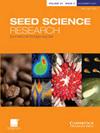兰花胚种比(E:S)作为萌发行为的指标及其生态学意义
IF 1.9
3区 生物学
Q2 PLANT SCIENCES
引用次数: 0
摘要
虽然各种兰科成员的种子可以很容易地在无菌营养培养基上发芽,但许多物种表现出完全的非共生发芽失败。此外,虽然兰花的种子形态以前与传播有关,但与发芽能力的关系尚未得到广泛探索。我们从国际文献和我们实验室未发表的发现中收集了全球203种兰花的种子形态和发芽数据。根据(a)最终萌发率和(b)预处理时间,出现了两组不同的非共生萌发行为-分别称为顺从和违抗。此外,发芽能力与胚与种子(E:S)长度比之间存在显著的统计学关系。E:S值在抗性萌发的物种中较低,而在适应性萌发的物种中较高。我们进一步将种子形态和萌发数据与系统发育和生态意义参数(亚科、生长形式、真菌异养水平、气候带和栖息地遮荫)进行了关联。值得注意的是,遮荫生境的兰科植物E:S值较低,抗性萌发率较高,而开放生境的兰科植物萌发率较高。最后,考虑到真菌异养连续体,我们提出E:S比率的降低与各种兰花谱系通过增加的扩散能力和对真菌共生的更大依赖来适应阴影栖息地有关。本文章由计算机程序翻译,如有差异,请以英文原文为准。
Orchid embryo-to-seed (E:S) ratio as an indicator of germination behaviour and its ecological implications
Although the seeds of various Orchidaceae members can be readily germinated on sterile nutrient media, numerous species exhibit complete asymbiotic germination failure. Also, while seed morphology in orchids has been previously linked to dispersal, associations with germinability have not been widely explored. We compiled seed morphometric and germination data for 203 orchid species globally, drawing from international literature and our lab's unpublished findings. Based on (a) final germination percentage and (b) pre-treatment duration, two distinct groups of asymbiotic germination behaviour emerged – termed compliant and defiant, respectively. Additionally, a statistically significant relationship between germinability and the embryo-to-seed (E:S) length ratio was observed. E:S values tended to be lower in species with defiant germination and higher in those with compliant germination. We further correlated seed morphometric and germination data with phylogenetically and ecologically significant parameters (subfamily, growth form, mycoheterotrophy level, climatic zone and habitat shadiness). Notably, lower E:S values and defiant germination predominate in orchids of shaded habitats, while compliant germination is more prevalent in open habitats. Lastly, considering the mycoheterotrophy continuum, we propose that the reduction in the E:S ratio is linked to the adaptation of various orchid lineages to shaded habitats through both an increased dispersal ability and their greater reliance on fungal symbiosis.
求助全文
通过发布文献求助,成功后即可免费获取论文全文。
去求助
来源期刊

Seed Science Research
生物-植物科学
CiteScore
3.60
自引率
4.80%
发文量
23
审稿时长
>12 weeks
期刊介绍:
Seed Science Research, the official journal of the International Society for Seed Science, is a leading international journal featuring high-quality original papers and review articles on the fundamental aspects of seed science, reviewed by internationally distinguished editors. The emphasis is on the physiology, biochemistry, molecular biology and ecology of seeds.
 求助内容:
求助内容: 应助结果提醒方式:
应助结果提醒方式:


